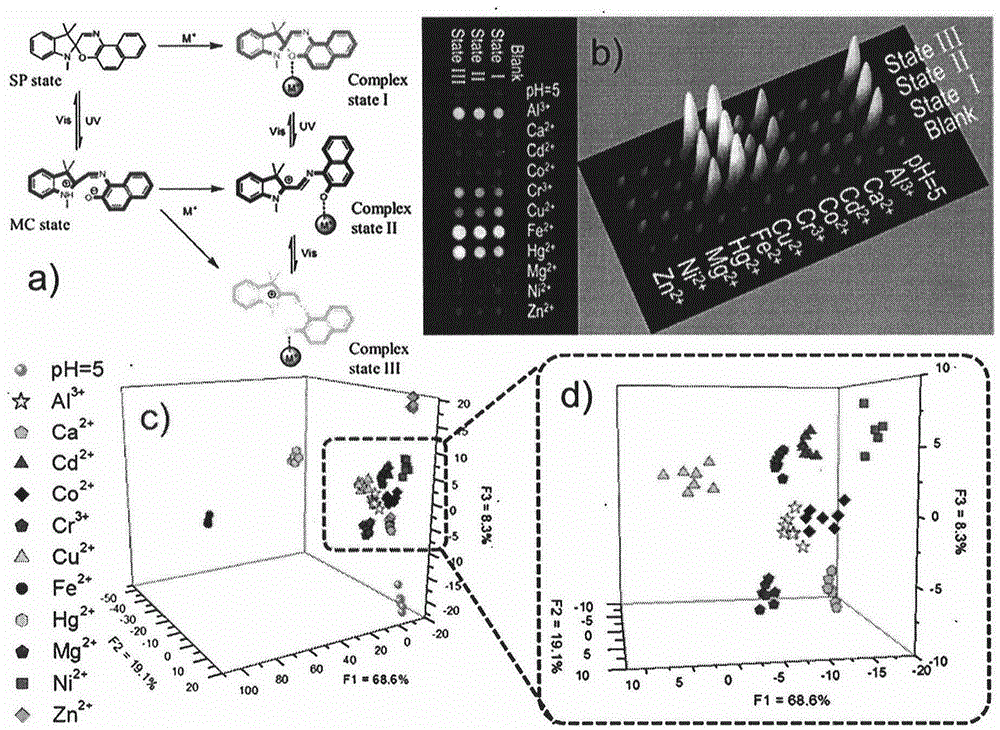Photochromic dynamic multi-substrate detection microchip and polymorphism analysis method
A photochromic and microchip technology, used in material excitation analysis, chemical instruments and methods, fluorescence/phosphorescence, etc., can solve the problems that limit the development and rapid preparation of high-efficiency detection chips, and achieve excellent environmental friendliness and chemical economy. The effect of sex, simple process
- Summary
- Abstract
- Description
- Claims
- Application Information
AI Technical Summary
Problems solved by technology
Method used
Image
Examples
Embodiment 1
[0031] 1) Select the metal cation as the substance to be detected. In the absence of light, the AlCl 3 , FeCl 3 , CoCl 2 , NiCl 2 , CuCl 2 , ZnCl 2 , HgCl2 , CdCl 2 , CaCl 2 , MgCl 2 Aqueous solutions of metal cations were spotted onto photochromic spirooxazine chips.
[0032] 2) Under the excitation of ultraviolet lamp (365nm), use a fluorescence scanner to perform fluorescence imaging and intensity recording on the chip under the filter of 450nm, 480nm, 505nm, 535nm, 570nm and 605nm wavelength respectively.
[0033] 3) Ultraviolet irradiates the detection chip for ten minutes, and uses a fluorescence scanner to perform fluorescence imaging and intensity recording on the chip under filter filters with wavelengths of 450nm, 480nm, 505nm, 535nm, 570nm and 605nm respectively.
[0034] 4) The detection chip was irradiated with visible light for ten minutes, and the fluorescence imaging and intensity recording were carried out on the chip under the filters of 450nm, 480nm...
Embodiment 2
[0037] 1) Amino acid is selected as the substance to be detected, and it is detected under the cooperation of spirooxazine and metal cations. In the absence of light, the FeCl 3 , CuCl 2 , HgCl 2 The metal cation aqueous solution is respectively dot-stained on the photochromic spirooxazine chip to make three detection chips. Ala, Arg, Cys, Gly, Lys, Pro, Met, Thr, Ser, His, Val, Tyr, Asn, Glu, Trp, Gln, Ile, Phe, Asp, Leu were stained on three chips.
[0038] 2) Under the excitation of ultraviolet lamp (365nm), use a fluorescence scanner to perform fluorescence imaging and intensity recording on the chip under the filter of 450nm, 480nm, 505nm, 535nm, 570nm and 605nm wavelength respectively.
[0039] 3) Ultraviolet irradiates the detection chip for ten minutes, and uses a fluorescence scanner to perform fluorescence imaging and intensity recording on the chip under filter filters with wavelengths of 450nm, 480nm, 505nm, 535nm, 570nm and 605nm respectively.
[0040] 4) The ...
Embodiment 3
[0043] 1) Dipeptide is selected as the substance to be detected, and detection is performed under the cooperation of spirooxazine and metal cations. In the absence of light, the FeCl 3 , CuCl 2 , HgCl 2 The metal cation aqueous solution was spot-stained on the photochromic spirooxazine chip respectively to make three detection chips. Spotting Val-Phe, Gly-Ala, His-Ala, Ala-His, Phe-Pro, Pro-Gly on three chips.
[0044] 2) Under the excitation of ultraviolet lamp (365nm), use a fluorescence scanner to perform fluorescence imaging and intensity recording on the chip under the filter of 450nm, 480nm, 505nm, 535nm, 570nm and 605nm wavelength respectively.
[0045] 3) Ultraviolet irradiates the detection chip for ten minutes, and uses a fluorescence scanner to perform fluorescence imaging and intensity recording on the chip under filter filters with wavelengths of 450nm, 480nm, 505nm, 535nm, 570nm and 605nm respectively.
[0046] 4) The detection chip was irradiated with visibl...
PUM
 Login to View More
Login to View More Abstract
Description
Claims
Application Information
 Login to View More
Login to View More - R&D
- Intellectual Property
- Life Sciences
- Materials
- Tech Scout
- Unparalleled Data Quality
- Higher Quality Content
- 60% Fewer Hallucinations
Browse by: Latest US Patents, China's latest patents, Technical Efficacy Thesaurus, Application Domain, Technology Topic, Popular Technical Reports.
© 2025 PatSnap. All rights reserved.Legal|Privacy policy|Modern Slavery Act Transparency Statement|Sitemap|About US| Contact US: help@patsnap.com



